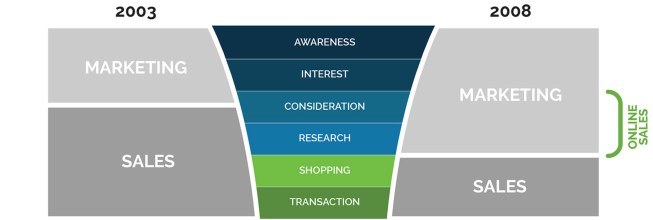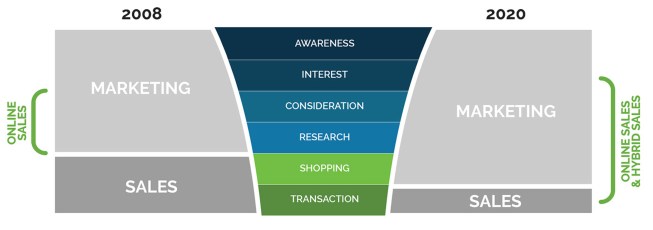There is often serious confusion among home building leaders about the role of advertising and marketing in their organizations. This leads to a serious lack of effectiveness and efficiency when the market is doing well, and can usher in disaster more quickly in times of stress like we are in right now. I want to help you avoid that disaster, and at the same time unlock the insights that will help you gain market share in the months ahead.
The Role of Advertising
Advertising’s main role is to shift the consumer’s attention into genuine interest. Attention is always in limited supply and arguably becoming more rare each year. Typical advertising interrupts. It jumps out and demands to be seen—often before you can continue on doing what you originally desired. The attention purchased by this ephemeral type of ad is fleeting. You have a couple of seconds of captured attention, and the ad’s job is to shift those moments into interest (the desire to seek out more information with intent) that can build over time into desire to purchase. Conceptually, you don’t pay to run ads. You pay for slices of attention from other human beings.
This is why the advertising budgets of many public home builders have been lowered from an average of around 1% pre-pandemic to 0.3% during 2021. How much extra attention did they need to purchase? Truthfully, many of them ended up spending money on resources and systems to try to deflect attention away from their sales teams. Now, as buyer psychology shifts on a dime, so, too, will the need for more attention to be purchased.
The role of advertising is nuanced and complex, but I don’t think it is as misunderstood as marketing so I’m not going to dedicate more time to it for now.
The Role of Marketing
Classically trained marketers would say that marketing is the entire process of creating, pricing, connecting, and delivering a product or experience to a customer. For now, I am going to simplify marketing’s role to the following: marketing builds certainty through all forms of content. Images, written word, data, experiences, and interfaces (websites, apps, etc.)—it all falls under content. Once advertising has piqued a consumer’s interest enough to begin seeking out more information around a product or service, marketing must engineer the way for the consumer to do what they desire with the least friction possible while simultaneously making sure the company is benefiting as well.
As certainty builds about your homes and communities meeting their wants and needs, the consumer’s emotional state begins to skyrocket as well. Once their emotional excitement exceeds their fear of being sold something that they may not want, they become a lead. Yes! Leads ARE humans. Shocking as that might be to some people in your organization. If leads are human, it means they are not created by marketers, but nurtured by them. “Our sales team needs more humans! Go get us more humans! Create more of them, this week!” Sounds a bit absurd, doesn’t it? Create more of them? Marketing can’t create anything but content that builds certainty in the mind of the customer.
Again, don’t limit the definition of content. If the customer interacts with it in any way, it is content that must strategically be managed by the marketer to help the customer build certainty that this will solve a problem for them. Your website falls under marketing and not IT for this reason. Yes, it is a tool powered by underlying technology, but none of that technology is something your customer actively cares about. “Yes! This site is programmed in AJAX!” is a phrase that has never been uttered by a home shopper.
Should you add a “buy now” button on your site? That’s a question marketing should answer, not IT, your website vendor, or the CEO. How do you display pricing—$442,900, “from the mid-$400s,” or keep price off entirely? Yes, that’s another question for marketing to answer. How should you stage a model home? Marketing.
A point of clarification lest you think I am arguing for a tyrannically powerful marketer. Great marketers will never come across as ego maniacs or tyrants because they must rely on all other parts of the organization for the inputs that inform their decisions. It is an inherently collaborative role. If marketing tries to go rogue outside of company culture and processes, brand dissidence felt by the consumer will cause more harm than good. You should never promise them something you can’t deliver.
The Role of Sales
Once certainty has created a rise in emotion high enough to overcome fear and the consumer reaches out to connect via form, phone, text, on-demand tour, or scheduled appointment, sales enters into the equation for the first time. The job of the sales department is to bring the motivation and energy necessary to choose to make a change. Change is never easy, and when it is imminent it creates a new form of fear that must be overcome. Customers need help removing the last bits of uncertainty, and encouragement to push through to better their lives. Don’t mistake my brevity on this topic for a lack of importance. I believe salespeople will always have a significant role to play, and it will expand with roles like online sales and hybrid sales.
The Shifting Level Of Customer Engagement Between Marketing and Sales
I began working in this industry in 2003. My main job as a marketer was to make sure the weekly newspaper (at the time, the company’s largest advertising expense since each week cost around $10,000) was as effective as possible. The second largest priority was signage and a bit of direct mail. That was the extent of marketing’s ability to interact directly with the consumer at scale. A few years later things began to shift as the internet and, later, the innovation of the iPhone gave marketing the ability to create more certainty through content earlier in the customer journey. By 2008, the scope of marketing’s role as part of the customer’s journey had nearly doubled.

Courtesy Kevin Oakley
This also ushered in the importance of the online sales role. Not because there were too many leads and they needed to be sifted through, but precisely because there weren’t enough leads to go around. In 2008, every phone call mattered. Every prospect got the royal treatment. Speed of response was paramount because if you connected with them first you could steal market share. If you are using your online sales team primarily as a way to make sure prospects are qualified enough to spend time with your sales team, you need to rethink that—quickly.
Marketing was tasked with a new challenge in 2020 when the pandemic hit. Sales offices closed, and interaction with the consumer, for a time, was relegated purely to the digital world. To be clear, online sales and hybrid sales roles also were asked to bridge a wider gap. The overlap though is still strategically driven by marketing, and the handoff to sales is driven 100% by the customer.

Courtesy Kevin Oakley
To respond to consumer demand for a better experience, marketing has needed to give them more options. Essentially, at every step along their journey the customer expects to be able to bounce back and forth between the physical and digital worlds without skipping a beat. They want to effortlessly go from looking at photo galleries online, to interacting with an online sales professional, to an on-demand self-guided tour, to a Zoom meeting with hybrid sales, and back to a face-to-face in the model home. They also may want to grow through the whole process the “old-fashioned” way—and that must be allowed, too.
Predominantly, our industry is not prepared to do this well, which creates huge opportunities for those that will figure it out. We typically want to build one system or one way of interacting with our company. Online or offline. Black or white. But the consumer demands gray and will willingly give their attention to the home builder that delivers the content and sales experience they want.
All Leaders Are Marketers
In our industry, marketing is typically relegated to promotion. The other P’s of marketing—price, product, place (land), and people—are ultimately controlled by the leadership team, division president, or CEO. The most important input into the success of advertising and marketing efforts are outside of most marketers’ direct control. I’m covering this topic last because you need the context of everything else we’ve discussed for this to really sink in.
Right now traffic to home builder websites is on average 2% higher than last year (June ’22 vs. June ’21), but conversion to lead is down 17%. Marketers can adjust messaging and calls to action, and they can provide more content around the homes for sale, but these will be small incremental improvements. Many builders right now are looking for larger, more impactful change. This won’t come from advertising. Advertising is still doing the job of converting attention into interest. They are on your website because of advertising. Marketers are doing their best to build certainty in an uncertain environment, but consumers are looking at the pricing (affordability) and the product (unfinished and mostly in disarray) and deciding not to take the next steps of becoming a lead or purchasing.
Leaders have to think and act like marketers to help address these issues, or bring marketing to the table to think creatively about how to repackage things for the customer to find certainty again. Don’t point the finger exclusively at advertising, marketing, or sales. Challenge everyone in your C-suite to think like a marketer to navigate the road ahead with greater clarity. This is exactly how our team at Heartland Homes in 2008 to 2012 grew by 20% a year by stealing market share. You can do it, too, right now.


